| Columns Retired Columns & Blogs |
Rotel RB 1080 power amplifier Measurements
Sidebar 3: Measurements
After the usual one-hour preconditioning at one-third power into 8 ohms, the Rotel RB 1080's chassis was pleasantly hot. However, the shrouded internal heatsinks (not those on the front panel) were way too hot to touch, which I assume is why they're protected from prying fingers.
The RB 1080's input impedance, measured at 1kHz, was to spec at 34k ohms (unbalanced) and 38k ohms (balanced), and the amplifier didn't invert signal polarity at either input. The voltage gain (into 8 ohms) was 28.4dB via the unbalanced RCA jack. This is slightly on the high side for a THX-certified design, but 6.7dB lower via the balanced XLR jack, which is very unusual.
The output impedance was very different in the two channels, measuring a superbly low 0.05 ohms from the right channel but a significantly higher 0.23 ohms from the left. Assuming the amplifier didn't malfunction during KR's auditioning, this suggests a QA problem at the Rotel factory. Nevertheless, even from the left channel, any response variations due to interaction between this source impedance and the manner in which the loudspeaker's impedance varies with frequency (fig.1, top trace) are no more than ±0.15dB. The other traces in this graph show that there is also a 0.25dB imbalance between channels (presumably due to the difference in output impedance), but that the response is flat within the audioband, rolling off to -3dB at 110kHz. (These responses were taken using the balanced input; the response via the unbalanced input, not shown, was identical.)
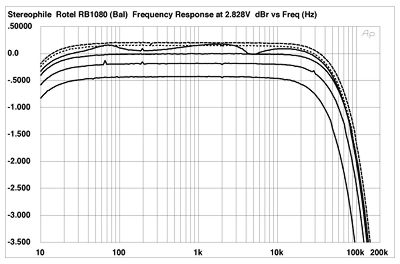
Fig.1 Rotel RB 1080, frequency response at (from top to bottom at 2kHz): 2.83V into dummy loudspeaker load, 1W into 8 ohms, 2W into 4 ohms, 4W into 2 ohms (right channel dashed, 0.5dB/vertical div.).
With such a flat audioband response, it is no surprise that a 1kHz squarewave was reproduced with an excellently square shape (fig.2). However, if you look very closely at this graph, a hint of overshoot can be seen. This is more clearly visible on the leading edges of a 10kHz squarewave (fig.3).

Fig.2 Rotel RB 1080, small-signal 1kHz squarewave into 8 ohms.
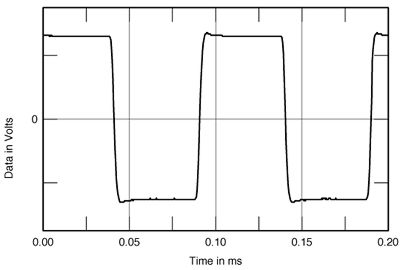
Fig.3 Rotel RB 1080, small-signal 10kHz squarewave into 8 ohms.
The Rotel features very low harmonic distortion at moderate power levels. Consequently, to examine how the THD varies with frequency, I used a high level of 25V RMS, which is equivalent to 78W into 8 ohms. The results are shown in fig.4. Even at this highish power level, the THD+noise percentage remains below 0.02% across the band into both 8 and 4 ohms from both channels. Only into 2 ohms (top trace) did the level of distortion rise significantly, but even then, it was still below 0.1%. The harmonic content of that distortion (fig.5, lower trace) consists of third and higher harmonics. At very high powers, however, the distortion content is very unusual in that it consists of the fourth, eighth, 12th, and 16th harmonics (fig.6), with very little of the usual second and third harmonics.

Fig.4 Rotel RB 1080, THD+N (%) vs frequency at 25V into (from bottom to top): simulated loudspeaker load, 8 ohms, 4 ohms, 2 ohms (right channel dashed, 5dB/vertical div.).
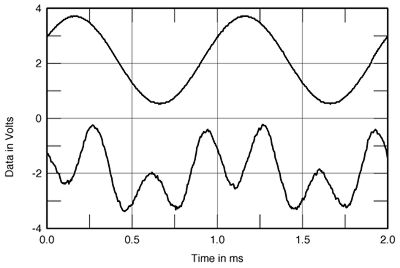
Fig.5 Rotel RB 1080, 1kHz waveform at 37W into 4 ohms (top), distortion and noise waveform with fundamental notched out (bottom, not to scale).
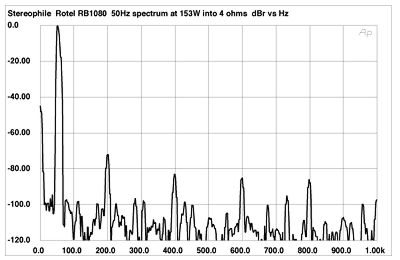
Fig.6 Rotel RB 1080, spectrum of 50Hz sinewave, DC-1kHz, at 153W into 4 ohms (linear frequency scale).
Nevertheless, the RB 1080 offered very low levels of intermodulation distortion, even at an output power close to clipping with the demanding mixture of 19kHz and 20kHz tones (fig.7).
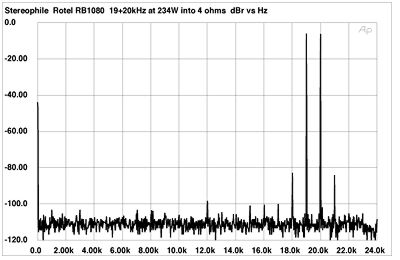
Fig.7 Rotel RB 1080, HF intermodulation spectrum, DC-24kHz, 19+20kHz at 234W into 4 ohms (linear frequency scale).
The Rotel has sophisticated output protection, in addition to 6.3A fuses in the positive and negative voltage rails for each channel. Nevertheless, during the high-power testing, I blew the rail fuses when I was testing the amplifier's continuous output into 2 ohms. Even after I'd replaced these fuses, the amplifier would not turn on again—even after I'd let it cool down and had reset it with the front-panel Power button. As a result, I couldn't measure the RB 1080's channel separation, S/N ratio, and power output on toneburst signals. However, I did examine its power capability in continuous drive with just one channel driven, using the Miller Audio Research Amplifier Profiler.
The results into 8 and 4 ohms are shown graphically in fig.8. Below 500mW or so, the calculated THD percentage (this FFT-based measurement does not include any contribution from noise) drops with increasing power, presumably because it is crossover-related. But distinct drops in the measured THD level can be seen at around 210mW into 8 ohms (red trace) and 420mW into 4 ohms (black trace), both equivalent to an output voltage of 1.3V RMS. In addition, temporary increases in THD (to still negligible levels, however) can be seen in both traces at powers equivalent to an output voltage of 4.2V. I have no idea to what this behavior is related, but I do wonder if it correlates with KR finding the amplifier to have different sonic characters at high and low powers.
Fig.8 shows that the RB 1080 clips quite suddenly. However, this is at very high power levels. Using the conventional 1% THD definition of clipping, the Rotel puts out 291W into 8 ohms with one channel driven (24.6dBW), 558W into 4 ohms (24dBW), and even 800W into 2 ohms (23dBW)! Considering its modest price, this is one powerhouse of an amplifier. But, as Rotel recommends in the handbook, the RB 1080 is best used with speakers whose impedances don't drop much below 2 ohms.—John Atkinson

Fig.8 Rotel RB 1080, distortion (%) vs continuous output power into 8 ohms (red trace) and 4 ohms (black).
- Log in or register to post comments




































